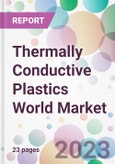While plastics are poor conductors of heat, the need to have lighter and more versatile thermally conductive materials has been instrumental in the development of a novel variety of these materials that possess thermal conductivity. The heat conduction in plastics is only through lattice vibrations since these materials are made up of covalently bonded polymeric chains whose electrons are closely bonded with the parent atoms, owing to which no valence electrons exist.
Thermally conductive plastic compounds provide the capacity of replacing metals, ceramics, and traditional plastics for heat-sensitive applications. The wide usage of these materials has been seen in sectors, such as electronics, automotive, aerospace, healthcare, telecommunications, and general industry, among others. To make plastics thermally conductive, it is required that they be integrated with appropriate fillers, which can primarily be carbon-based, ceramic-based, and metal-based, with mineral-based fillers also being widely used.
This world market compendium by the publisher analyzes the market for Thermally Conductive Plastics at a high level by plastic type, end-use sector, and geographic region. The market is studied for historical/current trends and future forecasts in terms of value in US$ for 2019, 2023, and 2028.
Plastic Type
- Polyamide (PA)
- Polybutylene Terephthalate (PBT)
- Polycarbonate (PC)
- Polyetherimide (PEI)
- Polyethylene (PE)
- Polyphenylene Sulfide (PPS)
- Polypropylene (PP)
- Polysulfones (PSUs)
- Other Plastic Types [Primarily including Epoxy, Poly(ether-ether-ketone) (PEEK) and Polyurethane (PU)]
End-Use Sector
- Aerospace & Defense
- Automotive
- Biomedical
- Electrical & Electronics
- Industrial
Geographic Region
- North America
- Europe
- Asia-Pacific
- Rest of World
This report provides estimates and forecasts for the global Thermally Conductive Plastics market. The study also provides the key market developments and a list of major players in this market that are cited.
Table of Contents
Companies Mentioned
- 3M Company
- AGC, Inc.
- Arkema Group
- Avient Corp
- BASF SE
- Celanese Corp
- Compagnie De Saint-Gobain SA
- Covestro AG
- Dow Chemical Company
- DSM NV
- E.I. Dupont De Nemours and Co
- Ensinger Group
- Huntsman International LLC
- Imerys SA
- Kaneka Corp
- Lanxess AG
- Mitsubishi Engineering-Plastics Corporation
- Ovation Polymers, Inc.
- RTP Company
- Saudi Basic Industries Corporation (SABIC)
- Solvay SA
- Sumitomo Chemical Co Ltd
- TE Connectivity
- Teijin Ltd.
- Toray Industries, Inc.
- UBE Corp








